Everyone in the 21st century knows about wireless technology, known as Bluetooth, which is used to transfer data between different electronic devices over a short distance. But what does this technology have to do with a Viking king, with bad dental hygiene, who lived almost 1000 years ago? To understand the answer, we have to take a journey back in time, from the skyscrapers lining the cities of the 21st century to a small village in Denmark, thousand years back, when a little boy was born to a pagan Viking king in Denmark.
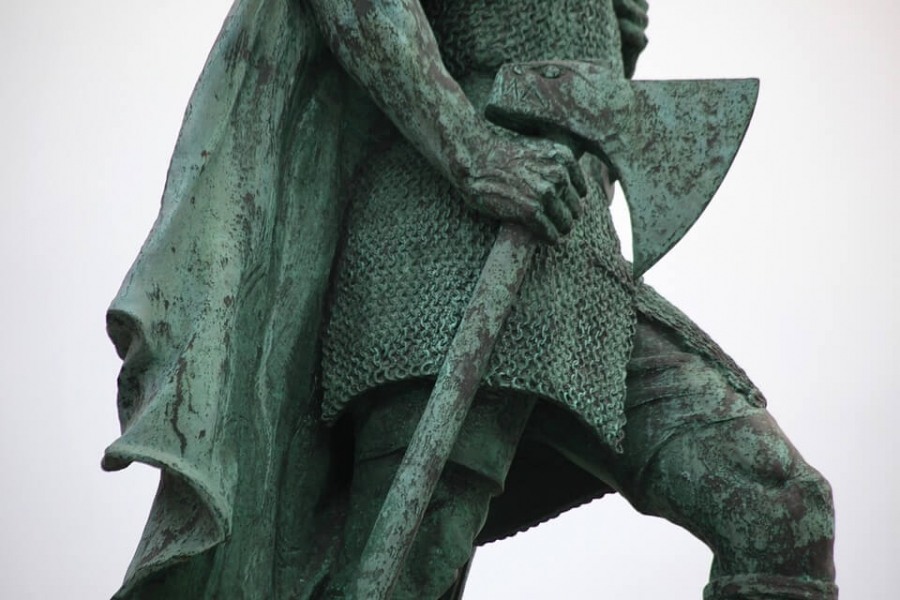
This boy, born to King of Denmark – Gorm the Old and his wife – Thyra, would later become famous as Harald Bluetooth, a famous King of Denmark, who played a very important role in the history of Denmark. But before we go into details of Harald Bluetooth, a brief description of his family and the times during which he lived, would be certainly helpful.
Although the exact date is not known, Harald Bluetooth was born around 911 AD, at a time when his country – Denmark was still divided into many factions. His father – Gorm the old, ruled from Jelling – a village located in Southern Denmark. Gorm the old, was supposedly descended from Ragnar Lodbrok, the legendary Viking hero. Although the ruler of only a portion of Denmark (Jutland), he was a proud follower of ancient traditions and worshipped ancient Norse gods. Gorm the old, had already started unifying Denmark, during his lifetime, which would later continue during Harald Bluetooth’s time.
Harald’s mother – Thyra, was inclined towards Christianity and it is believed that this may have played an important role, in the later conversion of Harald to Christianity. However, at the time it was not Harald, but his elder brother – Canute (Knud in Danish), who was supposed to inherit his father’s kingdom. Not just he was tall, strong and handsome but was also the favorite of his father and loved by the people. However, this prince charming would never inherit his father’s crown.
It was a time when Vikings raided and pillaged other European Kingdoms and the proud sons of Gorm the old, would also follow this cultural tradition. It was during an attempt to capture – Dublin, Ireland; to which the Viking army had laid siege, that Canute was hit by an arrow and died soon after. Although some conflicting reports mention that he died during, a conflict in Northumbria.
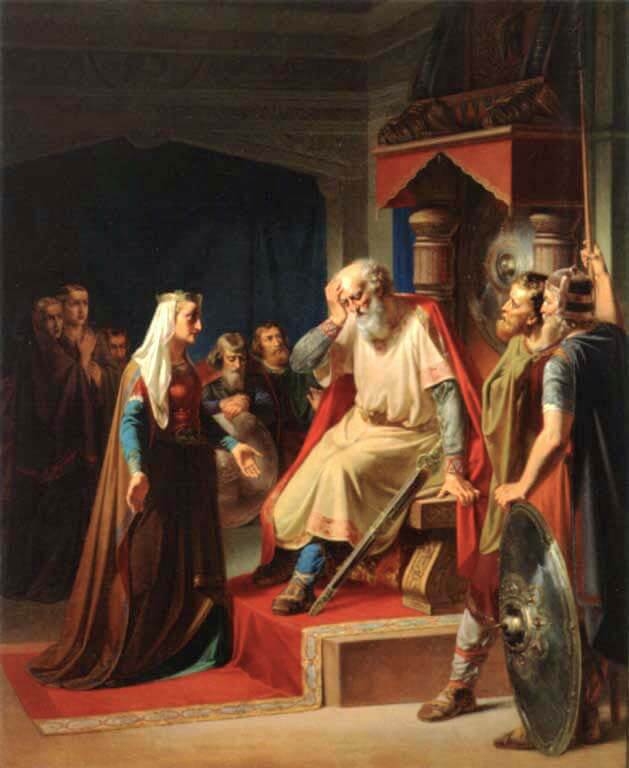
The unexpected death of Canute was very tragic news for Gorm the old, who was severely heartbroken. However, for Harald this tragedy changed his destiny forever, as after his father’s death in 958 AD, he was crowned the King. Harald Bluetooth’s time had finally come.
Harald Bluetooth Viking King - When Harald Bluetooth ascended to the throne, Denmark was divided into many clans each with its own King or Queen. Harald was a very ambitious person and soon took steps to conquer and unite all the different kingdoms. As a part of his strategy, he shifted his new capital (which was acquired by Harald himself) to Roskilde from Jelling, around the year 960. This would be the new capital of Denmark during Harald Bluetooth’s reign. The most important advantage of this new capital was that this allowed the King to base his administration at the center of power in the new kingdom.
He also decided to strengthen the existing fortifications, and also went on to build new ones. The most important of these was the fortification of the fortress of Aros, which was strategically located in a central position in his kingdom. Surrounding this in different directions were 5 Viking ring fortress (which were known as Trelleborg type fortress) all of which had a circular shape, with roads and gates pointing in 4 cardinal directions. A 6th fort also of similar design was also built by Harald Bluetooth in Scania in southern Sweden. These massive forts not just strengthened Harald’s position, but also helped in uniting the country (Denmark) into one kingdom.
He also decided to expand the defensive Viking wall – Dannevirke, a 30 km long, 20-meter-wide and 5-meter-tall Viking wall, whose function was to provide a defense against invasion from the south. This defensive wall to protect Denmark, not just protected the people but also the trade routes. Ravning Bridge, which can be considered as the oldest known bridge in Scandinavia, (760-metre-long and 5-metre-wide) near Jelling was another structure that was built by Harald Bluetooth to ensure that his army could travel in a faster way in Jutland.
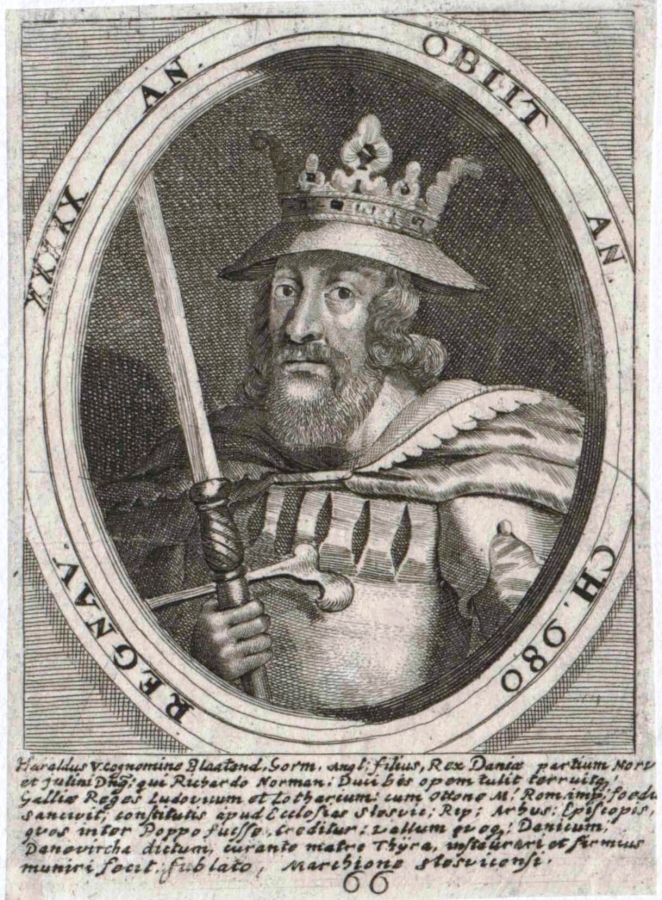
Once he had established himself inside Denmark, Harald Bluetooth focused on his neighboring domains, especially in Norway. His sister Gunnhild’s husband – King Erik Bloodaxe, the King of Norway had died in a battle and his 5 nephews along with their mother took shelter with Harald. Norway at the time was ruled by King Haakon. Harald used his might to reinstate his nephews back to their rightful place, with the eldest nephew – Harald Greycloak becoming the new king. However, Harald Greycloak was assassinated by his enemies, which gave Harald Bluetooth an opportunity to take over his nephew’s lands and on 970 AD, he became the King of Norway.
By the time of Harald Bluetooth, Christianity had made inroads to almost whole of Europe and the Viking lands were one of the very few places left that still followed the old pagan (in this case Norse) gods. However, the pressure was growing by the day. Harald Bluetooth’s father held strong faith in Viking gods and he lived his entire life with this faith. However, by the time of his son, the lands to the south of his kingdom were ruled by Otto the great (Otto I), the German King who later became Holy Roman Emperor. This champion of Christianity and mighty ruler of German – Roman Empire, was much stronger than Harald Bluetooth and his tiny kingdom in the north.
Harald realized that if he wanted to survive against this strong adversary from the south, he needed a better military infrastructure and divine help. He soon discovered that the god of Christians was the most powerful god when he saw a monk – Poppo, carry a great weight of iron, heated by a fire, in his hands easily, without getting burnt. This miracle restored Harald’s faith in Christianity, and he soon converted. Besides the incidence mentioned, many scholars also believe that Harald’s conversion was a much more pragmatic approach, with political motivation to avoid conflict with his neighbors in the south, who would have a much lesser chance of attacking another Christian kingdom, rather than a kingdom, which followed different religion and gods.

In some other conflicting reports, it is said that - Harald Bluetooth was forced to convert to Christianity after suffering defeat in battle in hands of – Otto I, the holy roman emperor. Whatever the cause may have been, Harald Bluetooth became the first Christian King of Denmark and was responsible for conversion of his people to Christianity. Soon many churches appeared all over Denmark. Even his father – Gorm the old, who had been buried as per pagan rituals of the time, had his body reburied in a church, by Harald Bluetooth.
Harald Bluetooth had led a remarkable life for a person of his time and it is a bit difficult to comprehend the way his life ended. Sweyn Forkbeard, a son of Harald Bluetooth, led a rebellion against his own father in which Harald Bluetooth received a mortal wound. According to the Saga of the Jomsvikings, Sweyn Forkbeard is described as an illegitimate son of Harald Bluetooth and a peasant girl, who was not acknowledged by Harald, as his son & raised elsewhere. The personal hate of the son for his father, along with the ambition to become the king fuelled a violent rebellion in 986 AD, in which opposition to Christianity, by nobles following old Viking gods also played an important role. The wounds sustained by Harald Bluetooth during the fight resulted in Harald’s death.
Harald Bluetooth reportedly died in Jomsborg, and was finally buried in Roskilde but unfortunately, his grave was never found. Gradually the Viking fortresses built by him would also be abandoned & the Ravning bridge, built by him was also no longer maintained. Maybe the new king of Denmark – Sweyn Forkbeard, deliberately wanted to erase his father’s legacy. However, even after the disappearance of major structures built by Harald Bluetooth, his name would live on.
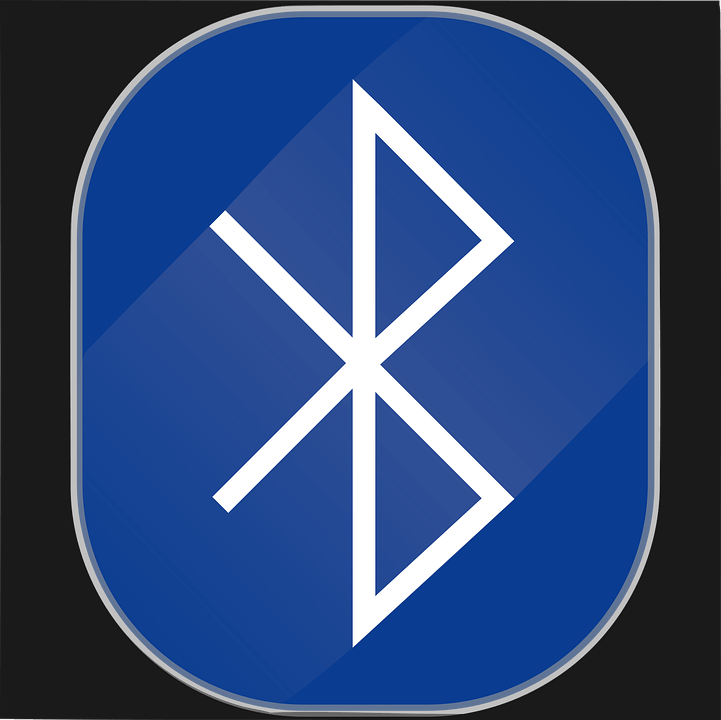
The most important testimonial of Harald Bluetooth comes from inscriptions found in a massive stone known as Jelling stone. According to local folklore, a stone initially discovered in the beach near the town of Vejle in Jutland was transported to Jelling on instructions of Harald Bluetooth, which later became famous as Jelling stone. In this inscription was made in Runes or Runic alphabets – the local Germanic language, used in Harald’s time.
The runic inscription in the Jelling stone describes how Harald had the Jelling stones erected to honor his parents. Finally, it adds that the monument was made by Harald Bluetooth, the conqueror of Denmark and Norway & who established Christianity among the Danish people. In the modern world, the Jelling stone is a part of UNESCO World Heritage Site list. This symbol of unification of Denmark and the formation of a country would also symbolize the achievements that Harald had wanted for himself and which ultimately became his identity, which would last to this day.
Harald had Bluetooth as his nickname (“Blatand” in Danish), and two different reasons have been given for this. The first belief is that the old Viking king suffered from a bad tooth, that may have turned dark or blue in color. The second belief is that the king may have loved the taste of blueberries or licorice, which may have given rise to this unconventional sobriquet.
The modern Bluetooth technology was invented by Jaap Haartsen, while he was working for the Swedish telecommunication company – Ericsson, in the 1990s. It was Jim Kardach, who came up with the name of this new technology and named it to reflect the company’s Viking heritage. The founders believed that as the Viking King – Harald Bluetooth, who had lived a 1000 years back had united his people as “one country, one people” & had revolutionarily changed the society by introducing Christianity, the modern invention would also unite the people (with better communication) & revolutionize the way people communicate.
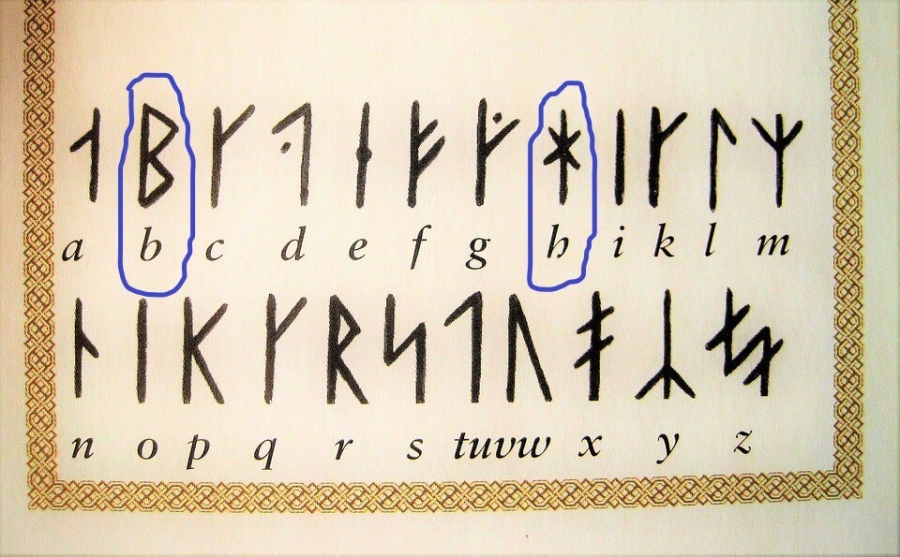
Here it would be prudent, to once again describe the Runes and Runic alphabets. As previously mentioned, runes are letters of runic alphabets. These were used to write various Germanic languages before Latin alphabets became more popular. The modern Bluetooth technology logo or symbol is a combination of H and B, the initials of the Viking King Harald Bluetooth when written in “Runes” – the ancient letters used by the Vikings.
All of us know about the Bluetooth technology, but the story about the real king inspiring the modern technology is surely worth telling. A King who lived a millennium back - attempting hard to unite different warring clans, trying to protect the sovereignty of his lands from foreign invaders, but at the same time introducing a new religion for keeping up with the changing times and finally dying tragically fighting a rebellious son is certainly stuff of legend.
But the thing with people like Harald Bluetooth is that they never really die. They just fade away in the pages of history, till someone searching for something unique rediscover them. So, the next time when you raise your finger to touch the Bluetooth icon on your electronic device, try to remember that you are reaching out to a proud but forgotten chapter of ancient history.
Must Read About: Ignaz Semmelweis